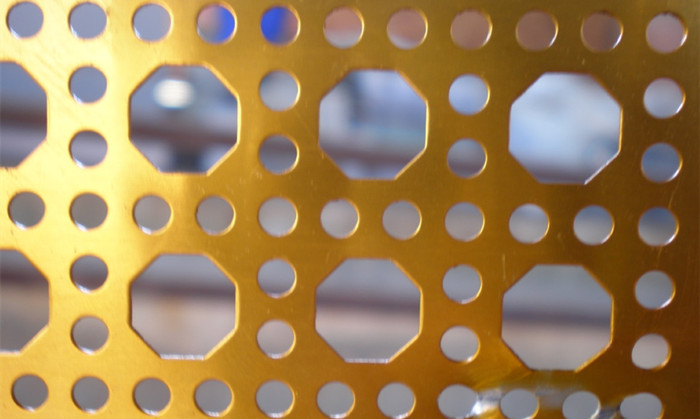Surface Treatment Methods for Perforated Metal Sheets with Round Holes
Source:www.cn-psp.cnAuthor:河北森驰公司 Last updated:2025-06-10 21:58:02 Browse:
Perforated metal sheets with round holes are widely used in architectural decoration, industrial manufacturing, acoustic engineering, and other fields due to their ventilation, filtration, and decorative functions. To improve corrosion resistance, appearance, and durability, surface treatment is usually applied after the sheets are fabricated. This article will introduce several common and effective surface treatment methods to help you choose the right option according to your needs.
1. Electroplating: Enhance Corrosion Resistance and Appearance
Electroplating is a common surface treatment method that applies a metal coating on the perforated sheet through an electrochemical process, enhancing corrosion resistance and overall aesthetics. Common types of electroplating include:
Zinc plating: Cost-effective, widely used in industrial applications to provide basic rust protection;
Chrome plating: Hard and glossy, suitable for applications requiring high decorative standards;
Nickel plating: Offers excellent gloss and wear resistance, ideal for harsh environments.
Electroplated perforated sheets not only look brighter but also have a longer service life, making it a cost-effective treatment option.
2. Spraying: Customizable Colors and Finishes
Spraying, also known as coating, involves evenly applying powder or liquid coatings on the metal surface, then curing at high temperature to form a durable protective layer. This process effectively isolates the metal from air, preventing rust and allowing customization of colors and finishes. Typical uses include:
Indoor and outdoor decorative panels;
Furniture components;
Industrial equipment housings.
Customers can choose various colors and coating types (e.g., epoxy resin, polyester powder) to achieve both functionality and aesthetics.
3. Anodizing: Specialized Treatment for Aluminum Sheets
Anodizing is primarily used for aluminum perforated sheets. It forms a dense oxide layer on the aluminum surface through an electrochemical reaction, enhancing wear resistance and corrosion protection. The anodized surface can also be dyed for improved appearance.
Advantages of anodizing include:
Increased surface hardness and scratch resistance;
Natural metallic luster or a wide range of colors;
Protection against oxidation in humid environments.
Anodized aluminum perforated sheets are widely used in curtain walls, ceilings, doors, and windows, combining functionality and beauty.

4. Brushing: High-End Textured Finish
Brushing mechanically creates fine linear textures on the metal surface, giving the sheet a unique matte metallic texture and decorative appeal. This method is often applied to products requiring a high-end look, such as:
Premium appliance casings;
Hotel decorative panels;
High-quality furniture metal parts.
Brushing not only enhances product texture but also helps conceal minor surface scratches, making it a popular surface treatment.
5. Polishing: Mirror-Like Surface Finish
Polishing can be performed mechanically, chemically, or electrochemically to smooth and brighten the metal surface. Depending on the need, options include:
Mechanical polishing: Using abrasive wheels and polishing cloths;
Chemical polishing: Applying chemical solutions to treat the surface;
Electropolishing: Combining electric current and chemicals for a finer finish.
Polished perforated sheets have minimal surface impurities and high gloss, ideal for elevator panels, stainless steel furniture, and other applications requiring excellent aesthetics.
6. Pickling and Passivation: Deep Cleaning for Stainless Steel
For stainless steel perforated sheets, pickling and passivation are essential surface treatments. Pickling removes oxidation scales, welding residues, and impurities, while passivation creates a stable oxide layer that enhances corrosion resistance.
This treatment is suitable for stainless steel products exposed to humid or corrosive environments, such as:
Chemical equipment housings;
Food processing facilities;
Medical device components.
7. Hot-Dip Galvanizing: Strong and Durable Weather Protection
Hot-dip galvanizing involves immersing the perforated metal sheet into molten zinc at high temperatures to form a thick, uniform zinc coating. The benefits include:
Excellent corrosion resistance, ideal for outdoor use;
Long coating lifespan, often exceeding 20 years;
Strong protection against harsh weather and industrial pollution.
Hot-dip galvanized perforated sheets are commonly used in highway guardrails, building facades, and agricultural facilities exposed to outdoor conditions.
Conclusion: Choose the Right Surface Treatment to Improve Durability and Appearance
Selecting the appropriate surface treatment method depends on your specific application and usage requirements. Whether you prioritize corrosion resistance, visual appeal, or weather durability, the above treatment options provide targeted solutions. If you are unsure which treatment best suits your product, feel free to contact our expert team for customized technical support and recommendations.
